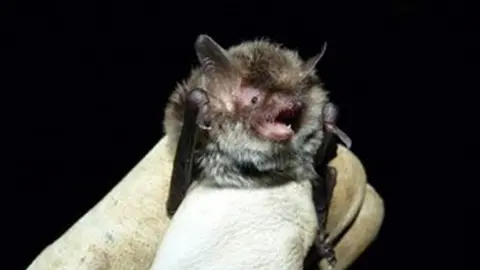Rare tiny bat discovered in caves in Wiltshire
 Keith Cohen
Keith CohenA tiny bat described as "one of the rarest mammals in Britain" has been discovered in caves in Wiltshire.
The alcathoe bat was found outside a stone mine near Bradford-on-Avon.
The bat, which is about the size of the end of a thumb, was identified following a DNA analysis of its droppings at the University of Sussex.
Prof Fiona Mathews, from the university, said: "It's incredibly exciting. We quite literally know almost nothing about [alcathoe bats]."
The species was only identified in Greece in 2001 and discovered in Britain, nine years later.
Despite a "lot of work to try and find it" the university said the bat had only been sighted before in North Yorkshire and a small area of Sussex and Surrey.
 Camilla Mitchell
Camilla MitchellThe female bat was captured by Keith Cohen and Danielle Linton, from the Wiltshire Bat Group, at a swarming site last autumn.
"This bat looked distinctly different from those we usually catch, so it was very exciting in case it could be an alcathoe bat," Mr Cohen said.
"Luckily we very soon also caught a whiskered bat, which is the species it looks most like, and could compare them side-by-side."
It was only after dropping samples were sent to Prof Mathews for DNA analysis that the identity of the species was confirmed.
"It's incredibly exciting for the alcathoe bat to have been found at this site," said Prof Mathews.
"The areas where it has been caught so far usually have old oak woodlands nearby, which is not the case with the bat we've just found.
"This only serves to illustrate exactly why we need to do more research about the species to understand its needs, and how we can protect it."

 Wiltshire bat Group
Wiltshire bat GroupAbout Myotis alcathoe
- Labelled as "data deficient" by the International Union for Conservation of Nature's Red List of Threatened Species
- According to present scarce knowledge, it is a tree dwelling and forest foraging species,
- The species was first discovered in Greece in 2001
- It is a small bat with reddish-brown fur
- The only known breeding colony was found in a tree hollow
Source: IUCN Red List

